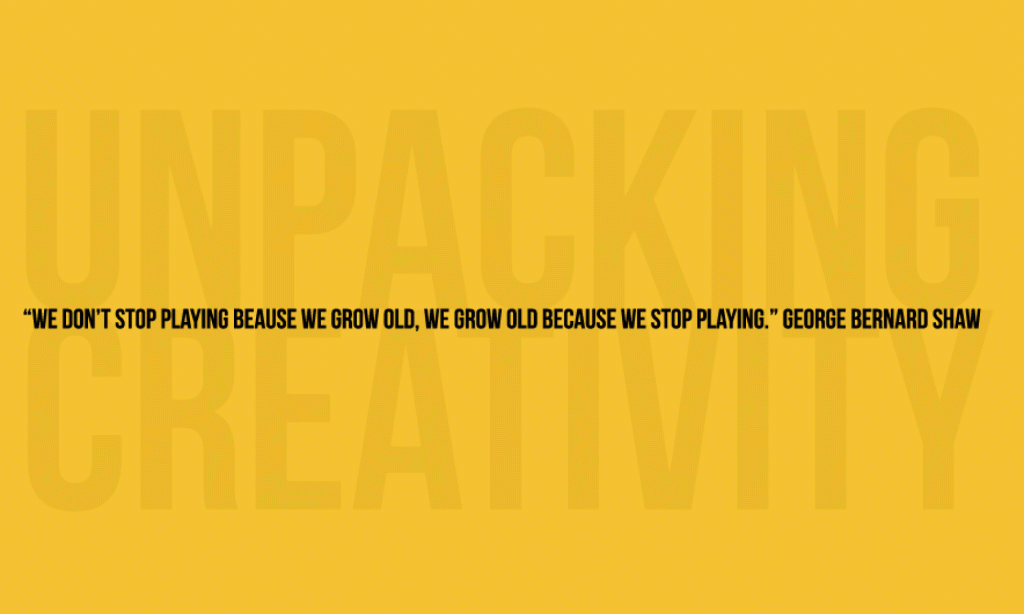I am attaching my presentation slides and the script I wrote for the presentation to share (in five minutes) what I did for over three months. Enjoy!

Today, I’m excited to share with you a glimpse into my research journey. My focus has been on reawakening creativity in adults and the methods I’ve employed to uncover insights in this area. Before I delve into my findings, let’s start with the fundamental question that guided my exploration.

How can we reignite creativity, given its decline in adulthood?
To tackle this, I embraced a Mixed Research Methodology:

- Action Research: to actively intervene and observe the effects of
creativity-enhancing activities. - Qualitative Methods: These allowed me to deeply explore participants’ perceptions,
experiences, and attitudes. - Questionnaires and Interviews: By collecting both structured and open-ended
responses, I gained a broader perspective on creativity. - Interventions: I conducted three creative workshops to test the impact of
interactive activities. - Longitudinal Research: Over two months, I maintained continuous
interactions with stakeholders to capture evolving insights.

My Interventions and Initial Evidence:

- Creativity Continuity Workshop: This one-hour workshop targeted UAL students. Through improv and artistic games, participants reported improved problem-solving using creativity. The need for ongoing sessions was highlighted.
- 21 day CREATIVITY CHALLENGE – which I will delve into more deeply during the presentation.
- Relaxed Creativity Workshop: A 1.5-hour workshop for diverse age groups yielded positive outcomes, with participants experiencing connection, innovation, and a shift in perspective.
The 21 day Creativity Challenge…..

- 21 ActivitIes
- 5 minutes a day
- 140 participants
- From 11 countries
- 4 Surveys. 2 polls, 2 surveys and individual conversations.

EVERY DAY HAD A CHALLENGE
EVERY CHALLENGE A NAME AND A PURPOSE.
FOR EXAMPLE.
Sounds of your day.
Stakeholders were told to: Not use headphones or take calls when taking a walk. Instead notice the sounds around you, write them down after the five minutes are up.

Positive feedback and anecdotal evidence revealed transformative shifts in participants’ self-perceptions and creativity.
For example, one participant told me at the beginning: “I am joining because it’s you. I was not born creative.” Throughout the challenge, she connected almost every day. At the end, she called and thanked me. “I realised at age 52 that in fact I am creative. I just didn’t know.” A month later, she sent me photos of her son’s dorm in college, which she had just decorated, saying: “Look at what I achieved after the creativity course!!!! I feel like Picaso!!.”

What did I learn?
My research led me to several key insights:
- Creativity does indeed decline in adulthood, with the need for rekindling becoming more pressing.
- Misconceptions about creativity- PEOPLE STILL TEND TO BELIEVE IT IS A TALENT
- Trust is crucial for individuals to embrace creative thinking.
- Curious individuals are more receptive to change.

Building on these findings, I plan to develop interventions tailored for specific groups, such as artists, teachers, and businesses. BOTH IN PERSON AND DIGITAL, WITH TARGETED GAMES FOR EACH GROUP, SMALLER GROUPS, AND WITH EXPERTS HELPING ME DEVELOP THE GAMES.
In conclusion, my research journey has provided me with a deeper understanding of reawakening creativity in adults. Through a comprehensive methodology, I’ve uncovered initial evidence that interventions and interactive challenges have the potential to transform perceptions of creativity. As I continue this exploration, I am excited about the potential to make a broader impact on how we perceive and nurture creativity in various aspects of life.
